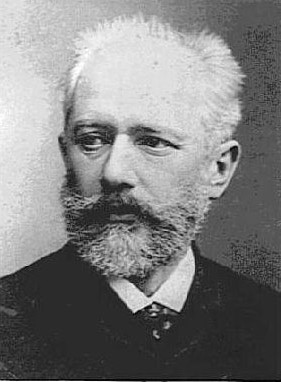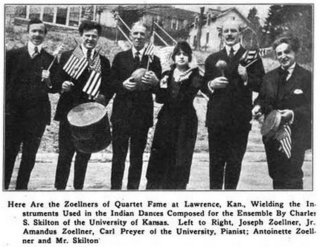
A string orchestra is an orchestra consisting solely of a string section made up of the bowed strings used in Western Classical music. The instruments of such an orchestra are most often the following: the violin, which is divided into first and second violin players, the viola, the cello, and usually, but not always, the double bass.

The Violin Concerto in D major, Op. 35 was the only concerto for violin composed by Pyotr Ilyich Tchaikovsky. Composed in 1878, it is one of the best-known violin concertos.
The Piano Quintet in F minor, Op. 34, by Johannes Brahms was completed during the summer of 1864 and published in 1865. It was dedicated to Her Royal Highness Princess Anna of Hesse. As with most piano quintets composed after Robert Schumann's Piano Quintet (1842), it is written for piano and string quartet.
Pyotr Ilyich Tchaikovsky's Trio in A minor, Op. 50, was written in Rome between December 1881 and late January 1882. It is subtitled À la mémoire d’un grand artiste [In memory of a great artist], in reference to Nikolai Rubinstein, his close friend and mentor, who had died on 23 March 1881. It is scored for piano, violin, and cello.

Ludwig van Beethoven completed his String Quartet No. 12 in E♭ major, Op. 127, in 1825. It is the first of his late quartets. Commissioned by Nicolas Galitzin over a year earlier, the work was not ready when it was scheduled to premiere. When it finally premiered by the Schuppanzigh Quartet, it was not well received. Only with subsequent performances by the Bohm Quartet and the Mayseder Quartet did it begin to gain public appreciation.

Pyotr Ilyich Tchaikovsky's Symphony No. 3 in D major, Op. 29, was written in 1875. He began it at Vladimir Shilovsky's estate at Ussovo on 5 June and finished on 1 August at Verbovka. Dedicated to Shilovsky, the work is unique in Tchaikovsky's symphonic output in two ways: it is the only one of his seven symphonies in a major key ; and it is the only one to contain five movements.

The String Quartet No. 19 in C Major, K. 465 by Wolfgang Amadeus Mozart, nicknamed "Dissonance" on account of its unusual slow introduction, is perhaps the most famous of his quartets.

The String Quartet No. 3 in E♭ minor, Op. 30, by Pyotr Ilyich Tchaikovsky, was composed in 1876, and is the last of his three string quartets. It was written as a memorial for Ferdinand Laub.
The String Sextet in D minor "Souvenir de Florence", Op. 70, is a string sextet scored for 2 violins, 2 violas, and 2 cellos composed in the summer of 1890 by Pyotr Ilyich Tchaikovsky. Tchaikovsky dedicated the work to the St. Petersburg Chamber Music Society in response to his becoming an Honorary Member. The work, in the traditional four-movement form, was titled "Souvenir de Florence" because the composer sketched one of the work's principal themes while visiting Florence, Italy, where he composed The Queen of Spades. The work was revised between December 1891 and January 1892, before being premiered in 1892. It is the only string sextet by the composer.
The six String Quartets, Op. 76, by Joseph Haydn were composed in 1797 or 1798 and dedicated to the Hungarian count Joseph Georg von Erdődy (1754–1824). They form the last complete set of string quartets that Haydn composed. At the time of the commission, Haydn was employed at the court of Prince Nicolaus Esterházy II and was composing the oratorio The Creation as well as Princess Maria Hermenegild Esterházy's annual mass.
The Op. 33 String Quartets were written by Joseph Haydn in the summer and Autumn of 1781 for the Viennese publisher Artaria. This set of string quartets has several nicknames, the most common of which is the "Russian" quartets, because Haydn dedicated the quartets to the Grand Duke Paul of Russia and many of the quartets were premiered on Christmas Day, 1781, at the Viennese apartment of the Duke's wife, the Grand Duchess Maria Feodorovna. Some scholars theorize that the "Russian" quartets were the inspiration for Mozart's six string quartets dedicated to Haydn, but no direct evidence has been found.

The Piano Quartet No. 3 in C minor, Op. 60, completed by Johannes Brahms in 1875, is scored for piano, violin, viola and cello. It is sometimes called the Werther Quartet after Goethe's The Sorrows of Young Werther. The premiere took place in Vienna on November 18, 1875, to an anxious public. Richard Wagner and his wife Cosima were in attendance.

The Piano Quartet No. 1 in G minor, Op. 25, was composed by Johannes Brahms between 1856 and 1861. It was premiered in 1861 in Hamburg, with Clara Schumann at the piano. It was also played in Vienna on 16 November 1862, with Brahms himself at the piano supported by members of the Hellmesberger Quartet. Like most piano quartets, it is scored for piano, violin, viola, and cello.
The String Sextet No. 1 in B♭ major, Op. 18, was composed in 1860 by Johannes Brahms and premiered 20 October that year in Hanover by an ensemble led by Joseph Joachim. It was published in 1862 by the firm of Fritz Simrock.
The String Quartet No. 2 in F major, Op. 22, by Pyotr Ilyich Tchaikovsky, was composed between December 1873 and January 1874. It premiered on 22 March 1874.
Variations on a Theme by Tchaikovsky, Op. 35a, a piece for string orchestra by Anton Arensky, started out as the slow movement of his String Quartet No. 2 in A minor, Op. 35, for the unusual scoring of violin, viola, and 2 cellos. It was written in 1894, the year after the death of Pyotr Ilyich Tchaikovsky, in a tribute to that composer. It is based on the theme from the song "Legend", the fifth of Tchaikovsky's Sixteen Children's Songs, Op. 54.

The Piano Quartet in E♭ major, Op. 47, was composed by Robert Schumann in 1842 for piano, violin, viola and cello. Written during a productive period in which he produced several large-scale chamber music works, it has been described as the "creative double" of his Piano Quintet, finished weeks earlier. Though dedicated to the Russian cellist Mathieu Wielhorsky, it was written with Schumann's wife Clara in mind, who would be the pianist at the premiere on 8 December 1844 in Leipzig.

The Zoellner Quartet was a string quartet active during the first quarter of the 20th century. It was once described as "the most celebrated musical organization in the West which devotes its energies exclusively to the highest class of chamber music." After training in Europe, the group in its prime years toured widely throughout the United States. Although all members were natives of Brooklyn, New York, the ensemble formed a strong early association with Belgium and in publicity often billed itself as "The Zoellner Quartet of Brussels"; its ultimate base of operations was in California. With one brief interruption at the end of World War I, the membership remained constant throughout the quartet's existence: Joseph Zoellner and his children Antoinette; Amandus; and Joseph, Jr. A second "Zoellner Quartet" was later formed by Joseph, Jr. and three unrelated musicians.
The Quartet Movement in B♭ major, TH 110, also referred to as String Quartet in B♭ major or String Quartet Movement in B♭ major, by Pyotr Ilyich Tchaikovsky is believed to be the only surviving movement of his first attempt to compose a string quartet.










